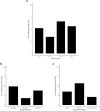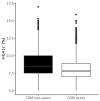Patient Demographics and Clinical Outcomes Among Type 1 Diabetes Patients Using Continuous Glucose Monitors: Data From T1D Exchange Real-World Observational Study
- PMID: 34632823
- PMCID: PMC10012384
- DOI: 10.1177/19322968211049783
Patient Demographics and Clinical Outcomes Among Type 1 Diabetes Patients Using Continuous Glucose Monitors: Data From T1D Exchange Real-World Observational Study
Abstract
Background: The benefits of Continuous Glucose Monitoring (CGM) on glycemic management have been demonstrated in numerous studies; however, widespread uptake remians limited. The aim of this study was to provide real-world evidence of patient attributes and clinical outcomes associated with CGM use across clinics in the U.S. based T1D Exchange Quality Improvement (T1DX-QI) Collaborative.
Method: We examined electronic Health Record data from eight endocrinology clinics participating in the T1DX-QI Collaborative during the years 2017-2019.
Results: Among 11,469 type 1 diabetes patients, 48% were CGM users. CGM use varied by race/ethnicity with Non-Hispanic Whites having higher rates of CGM use (50%) compared to Non-Hispanic Blacks (18%) or Hispanics (38%). Patients with private insurance were more likely to use CGM (57.2%) than those with public insurance (33.3%) including Medicaid or Medicare. CGM users had lower median HbA1c (7.7%) compared to nonusers (8.4%). Rates of diabetic ketoacidosis (DKA) and severe hypoglycemia were significantly higher in nonusers compared to CGM users.
Conclusion: In this real-world study of patients in the T1DX-QI Collaborative, CGM users had better glycemic control and lower rates of DKA and severe hypoglycemia (SH) events, compared to nonusers; however, there were significant sociodemographic disparities in CGM use. Quality improvement and advocacy measures to promote widespread and equitable CGM uptake have the potential to improve clinical outcomes.
Keywords: Type 1; continuous glucose monitoring; diabetes mellitus; diabetic ketoacidosis; hemoglobin A1c; severe hypoglycemia.
Conflict of interest statement
The author(s) declared the following potential conflicts of interest with respect to the research, authorship, and/or publication of this article: DJD has received independent consulting fees from Dexcom and Insulet. N. N., C. X., S. D. C., S. M., R. J. M., S. P., R. I., N. R., R. W., K. O., A. R., F. V., J. S., and O. E. have no disclosures.
Figures


Similar articles
-
Transatlantic Comparison of Pediatric Continuous Glucose Monitoring Use in the Diabetes-Patienten-Verlaufsdokumentation Initiative and Type 1 Diabetes Exchange Quality Improvement Collaborative.Diabetes Technol Ther. 2022 Dec;24(12):920-924. doi: 10.1089/dia.2022.0248. Epub 2022 Sep 2. Diabetes Technol Ther. 2022. PMID: 35947079
-
Effect of Continuous Glucose Monitoring on Glycemic Control in Adolescents and Young Adults With Type 1 Diabetes: A Randomized Clinical Trial.JAMA. 2020 Jun 16;323(23):2388-2396. doi: 10.1001/jama.2020.6940. JAMA. 2020. PMID: 32543683 Free PMC article. Clinical Trial.
-
Disparities in Continuous Glucose Monitoring Use Among Women of Reproductive Age with Type 1 Diabetes in the T1D Exchange.Diabetes Technol Ther. 2023 Mar;25(3):201-205. doi: 10.1089/dia.2022.0412. Epub 2023 Feb 8. Diabetes Technol Ther. 2023. PMID: 36753706 Free PMC article.
-
Impact of Continuous Glucose Monitoring and its Glucometrics in Clinical Practice in Spain and Future Perspectives: A Narrative Review.Adv Ther. 2024 Sep;41(9):3471-3488. doi: 10.1007/s12325-024-02943-5. Epub 2024 Aug 2. Adv Ther. 2024. PMID: 39093492 Free PMC article. Review.
-
CONTINUOUS GLUCOSE MONITORING: A CONSENSUS CONFERENCE OF THE AMERICAN ASSOCIATION OF CLINICAL ENDOCRINOLOGISTS AND AMERICAN COLLEGE OF ENDOCRINOLOGY.Endocr Pract. 2016 Aug;22(8):1008-21. doi: 10.4158/EP161392.CS. Epub 2016 May 23. Endocr Pract. 2016. PMID: 27214060
Cited by
-
Severe (level 3) hypoglycaemia occurrence in a real-world cohort of adults with type 1 or 2 diabetes mellitus (iNPHORM, United States).Diabetes Obes Metab. 2023 Dec;25(12):3736-3747. doi: 10.1111/dom.15268. Epub 2023 Sep 13. Diabetes Obes Metab. 2023. PMID: 37700692 Free PMC article.
-
Barriers to Uptake of Open-Source Automated Insulin Delivery Systems: Analysis of Socioeconomic Factors and Perceived Challenges of Caregivers of Children and Adolescents With Type 1 Diabetes From the OPEN Survey.Front Clin Diabetes Healthc. 2022 Jul 25;3:876511. doi: 10.3389/fcdhc.2022.876511. eCollection 2022. Front Clin Diabetes Healthc. 2022. PMID: 36992765 Free PMC article.
-
The Urgent Need for Breakthrough Therapies and a World Without Type 1 Diabetes.Diabetes Ther. 2025 Jun;16(6):1063-1076. doi: 10.1007/s13300-025-01735-6. Epub 2025 Apr 11. Diabetes Ther. 2025. PMID: 40214899 Free PMC article.
-
NIH Fifth Artificial Pancreas Workshop 2023: Meeting Report: The Fifth Artificial Pancreas Workshop: Enabling Fully Automation, Access, and Adoption.J Diabetes Sci Technol. 2024 Jan;18(1):215-239. doi: 10.1177/19322968231201829. Epub 2023 Oct 9. J Diabetes Sci Technol. 2024. PMID: 37811866 Free PMC article.
-
Interventions to address global inequity in diabetes: international progress.Lancet. 2023 Jul 15;402(10397):250-264. doi: 10.1016/S0140-6736(23)00914-5. Epub 2023 Jun 22. Lancet. 2023. PMID: 37356448 Free PMC article.
References
-
- Beck RW, Riddlesworth T, Ruedy K, et al.. Effect of continuous glucose monitoring on glycemic control in adults with type 1 diabetes using insulin injections: the DIAMOND randomized clinical trial. JAMA. 2017;317(4):371-378. - PubMed
-
- Lind M, Polonsky W, Hirsch IB, et al.. Continuous glucose monitoring vs conventional therapy for glycemic control in adults with type 1 diabetes treated with multiple daily insulin injections: the GOLD randomized clinical trial. JAMA. 2017;317(4):379-387. - PubMed
Publication types
MeSH terms
Substances
LinkOut - more resources
Full Text Sources
Medical

